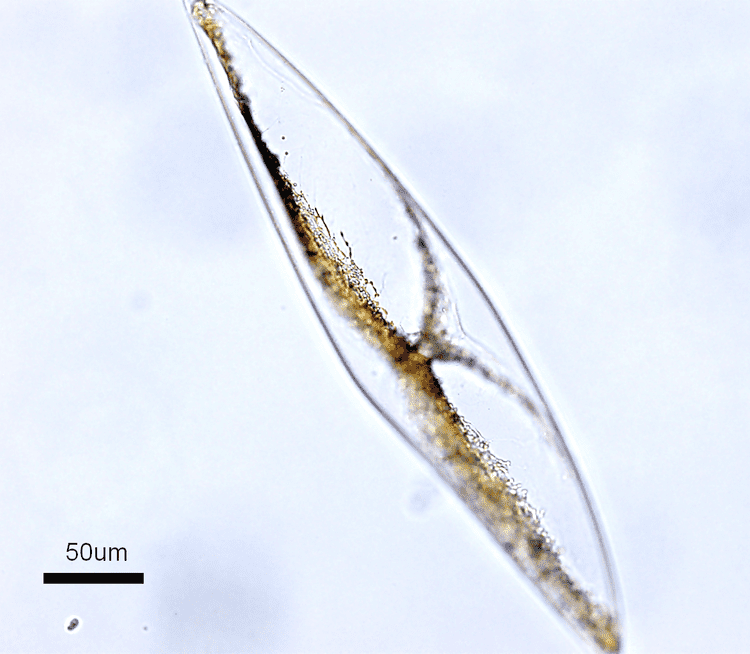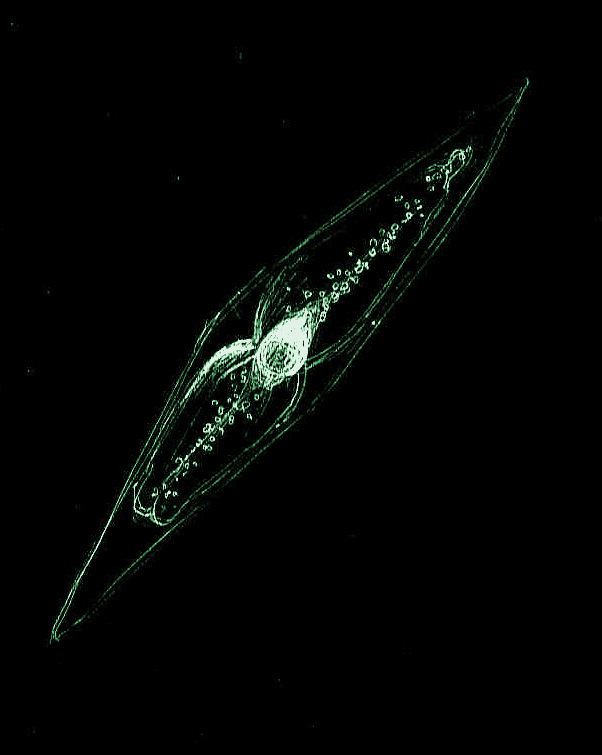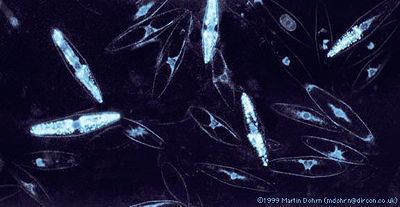Domain Eukaryota Family Pyrocystaceae Scientific name Pyrocystis fusiformis Rank Species | Suborder Goniodomineae Genus Pyrocystis Phylum Dinoflagellata | |
 | ||
Similar Noctilucales, Gonyaulax, Ceratium, Lingulodinium polyedrum, Dinoflagellate | ||
Pyrocystis fusiformis bioluminescence
Pyrocystis fusiformis is a non-motile, tropical, epipelagic, marine dinoflagellate (flagellate microorganisms), reaching lengths of up to 1 mm. They are especially interesting to many because of their bioluminescent nature which is displayed when P. fusiformis is disturbed or agitated. In the coastal marine waters, this dinoflagellate causes glowing effects after dark. P. fusiformis was first described in the Proceedings of the Royal Society of London in 1876.
Contents

Morphology

P. fusiformis's name is derived from its tapered or spindle shape. P. fusiformis is non-motile, which is a characteristic of all members of family Pyrocystaceae, which lose their flagellum by the time these organisms are adults. Each cell is approximately 970 x 163 µm and have a spherical diameter of 374 µm. The cell's chloroplasts actually change the cell's shape as they move closer to the cell's wall in daytime and retract towards the nucleus at night.

Bioluminescence is produced through activation of luciferase in the cell's plasma membrane. This produces a bright blue color. The genome of P. fusiformis contains shared common origin with other dinoflagellates of the luciferase gene.
Life Cycle

P. fusiformis is autotrophic, deriving their energy from the sun through photosynthesis. P. fusiformis will only photosynthesize during daylight hours and mostly produce bioluminescence during night because of their circadian rhythm which controls both processes.

P. fusiformis has a full life cycle of approximately 5–7 days and reproduces asexually. The reproduction phase creates 1 or 2 zoospores which grow inside of the parent's cell wall until they become new cells.
Ecology
P. fusiformis occurs most frequently at a depth of 60 and 100 meters in marine waters, tropical and subtropical bays and also oligotrophic waters. This species has been found in Taiwan, the Adriatic Sea, Black Sea, Canary Islands, Baja California, Brazil, India, China and Australia.
P. fusiformis is preyed upon by various organisms, such as grass shrimp, mosquito fish, mysids, and copepods. The production of bioluminescence by this species is thought to be a defense mechanism that startles grazers which would otherwise eat them or to illuminate grazers so that they, in turn may be more visible to their own predators.
P. fusiformis fixes carbon, removing it from the atmosphere. It also produces a large amount of oxygen for the Earth's atmosphere.
Human Interest
P. fusiformis is interesting to humans as a natural phenomena, for scientific study and also, because they are easy to grow in classrooms or at home, as science and art projects. On October 8, 2014, Biological & Popular Culture, Inc, released an educational toy known as the Dino Pet which contains P. fusiformis in order to make the toy glow.
Because P. fusoformis only flashes when agitated, it could be utilized in flow visualization to help spot differences in water flow or disruption of water by predators. P. fusiformis can also be used as a bioassay tool in order to detect pollutants in marine waters. Scientists measure the amount of light that P. fusiformis (and other dinoflagellates) in order to measure the effects of pollution since the amount of light produced is related to how healthy these organisms are.
P. fusiformis is the main subject of a series of works by artist, Erika Blumenfeld, who has shown her work in museums and galleries around the world. Working with scientists at the Scripps Institution of Oceanography, Erika photographs P. fusiformis in order to "activate a dialogue about our natural environment and our relationship to it." Her photographs are large scale and demonstrate the beautiful blue color that P. fusiformis produces when agitated.
